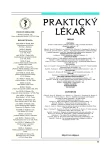Diagnosis and treatment patient with acute endocarditis
Infekční endokarditida na interním oddělení nemocnice 1. typu
Autoři předkládají vlastní pozorování pacienta s akutní endokarditidou nativní aortální chlopně se stanovením diagnózy již v pozdním stadiu – s komplikacemi: významnou aortální regurgitací a známkami levokomorové srdeční slabostí, příčinou vzniku byla exacerbace chronického infektu v uropoetickém systému. Prezentují diagnostické a terapeutické postupy, které vedly k definitivnímu vyléčení pacienta.
Klíčová slova:
akutní endokarditida – srdeční selhání – diagnostika – léčba.
Authors:
R. Dudrík 1; A. Vodzinská 2
Authors‘ workplace:
Interní oddělení Nemocnice, s. r. o., Rýmařov
primář MUDr. P. Opletal
1; Kardiocentrum Nemocnice Třinec Podlesí, primář MUDr. M. Branny
2
Published in:
Prakt. Lék. 2005; 85(2): 91-94
Category:
Case Report
Overview
Authors describe the case history of patient with acute endocarditis of native aortic valve with following establishmet of the diagnosis in late period – with complications: severe aortic regurgitation and features of left ventricule heart failure, it was caused by chronic inflamatory proces reactivation in urinary tract. They present diagnostic and therapeutic methods leading to definitive treatment of patient.
Key words:
acute endocarditis – heart failure – diagnostic – treatment.
Labels
General practitioner for children and adolescents General practitioner for adultsArticle was published in
General Practitioner

2005 Issue 2
- Memantine Eases Daily Life for Patients and Caregivers
- Metamizole at a Glance and in Practice – Effective Non-Opioid Analgesic for All Ages
- Metamizole vs. Tramadol in Postoperative Analgesia
- Memantine in Dementia Therapy – Current Findings and Possible Future Applications
- What Effect Can Be Expected from Limosilactobacillus reuteri in Mucositis and Peri-Implantitis?
Most read in this issue
- Brachyspirae – agents of intestinal spirochetosis
- The diabetic foot and hyperbaric oxygen therapy
- Treatment of traumatic lesions of the brachial plexus
- Inborn anomalies of the coronary arteries: three case reports
